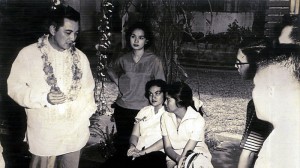If Carlos Vander Tolosa was the most-admired and Chaning Carlos the most-loved movie director in the Sampaguita studio, it was Octavio Silos (“Paru-Parong Bukid”) who was the most respected—and deserving of the title, “Dean of Movie Directors.”
He mastered the craft of movie-making in the pioneering prewar years by spending most of his time in the laboratory, where black-and-white films were processed after shooting.
When Banahaw Pictures was formed in the early ’30s, he joined the outfit as its art director, but soon moved to Filippine Films to train under Americans, Stewart Harris and Eddie Tait, who put up the first talking-pictures studio in the country.
Creative team
Octavio was the eldest of the Silos brothers, who formed Filippine Films’ creative team. He was an art director who also directed his own scripts, similar to what Manuel did in the bodabil days. Cesar was their cinematographer, Augusto worked in the lab, and Luis worked on their movies’ soundtracks.
On his first shooting day as director of “Hinagpis ng Magulang,” which was shot in Calamba, Laguna, he reminisced, “I was very happy, because Roger (Rogelio dela Rosa), who portrayed a young farmer, surprised us with his fine acting and enthusiasm. I thought, ‘My first picture would surely be a success if everything went as smoothly as this!’”
But, the next day, Dela Rosa, who had gone home to Manila, failed to show up. Many hours later, there still was no sign of him! The young actor had apparently signed up with them not knowing that it was illegal for him to do so, because a previous commitment with Malayan Pictures was still in force!
In hot water
“The company threatened him with legal action—so, with regret, we had to replace him,” said Octavio. “Much later, when I worked with Rod again, we had a lot of laughs over the incident.”
Before WWII, Octavio had worked with different studios and helmed box-office hits, including Parlatone’s “Kalupitan ng Tadhana”; the team-up of child stars, Tita Duran and Angelito Nepomuceno, in “Sa Paanan ng Krus”; Sampaguita’s “Inang Mahal”; Excelsior’s “Tunay na Ina”; the Rudy Concepcion-Rosario Moreno starrers, “Ikaw Rin” and “Pakiusap”, and Jaime dela Rosa’s first starrer, “Ibong Sawi” (1941).
After the war, when Sampaguita Pictures resumed producing movies, the director helmed the remakes of his prewar movies (“Pasang Krus,” “Mapait na Lihim,” “Alipin ng Palad,” and his biggest musical production, “Paru-Parong Bukid,” starring Gloria Romero, Luis Gonzales and Dolphy.
When Sampaguita’s Mommy Vera, Doc Perez and Nene Vera-Perez decided to build up more stars and launch new directors, they turned to Octavio, who didn’t let them down.
He was a generous mentor who was willing to codirect with neophyte directors who showed promise, like Carlos, Maning Borlaza and Ben Feleo. He eagerly listened to those who came to him for advice, like Eddie Garcia, Rosa Mia, Tony Cayado and Jose de Villa.
He was married to Soledad Tapales, with whom he had four children. His son, Raul, also became a director. A deeply religious Catholic, Silos was 67 when he passed away in 1971.
